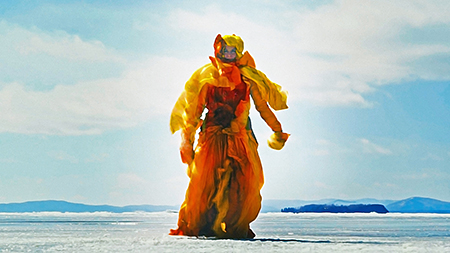
Antonia Wright's installation of opposing forms, "Under the water was sand, then rocks, miles of rocks, then fire" is full of ambition. It runs warm and then cool: galleries filled with a maze of suspended, pine tree-like plants in boxes lead towards a film projection that is only cool in its medium. The fragrance of the plants in the unlit gallery offer a welcome visceral experience that arguably becomes fully legitimized by the accompanying content, which takes the form of the film. Florescent lights are timed to bathe the plants in light each afternoon; the video stops and the music transitions to signal the shift, which then reverses the following morning.
In the film, the artist herself is seen moving in slow-motion across an ice-covered lake, attired in handmade survival gear cobbled together from what appears to be flame-colored, recycled parachutes. Accompanied by an enveloping soundscape by composer Jason Ajemian, Wright's eventual plunge through a hole into icy water comes off as a rather anticlimactic hybrid of performance art and an experimental music performance. The effect is to dilute the intriguing source of the film's story: a re-creation of an accidental submersion in a frozen reservoir Wright experienced as a 15-year-old. The filmed plunge is so choreographed that the very real physical stakes have all but disappeared. Still, the eye-level hanging plants provide a consequential drama of their own. The film, imperfect as it may be, is a dramatic contrast to the earthen installation.
